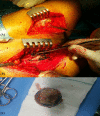Knee and Hip Joint Replacement Surgery in a Patient with Ochronotic Arthropathy: Surgical Tips
- PMID: 30637315
- PMCID: PMC6310191
Knee and Hip Joint Replacement Surgery in a Patient with Ochronotic Arthropathy: Surgical Tips
Abstract
Ochronosis or black joints disorder is a rare autosomal recessive disorder caused by deficiency of homogentisic acid oxidase. Orthopaedic manifestations are common and mostly involve spine and large joints such as knee and hip. Arthropathy is progressive and will eventually leads to arthroplasty. Not being familiar with this disorder might lead to devastating complications. We present a 57 year-old woman with Ochronosis who successfully underwent cemented cruciated substituted knee replacement and cementless hip replacement. Proper orthopaedic and anesthetic pre-operative preparation, soft tissue specially patella tendon management throughout operation and meticulous bleeding control during surgery are crucial. The results of the knee and the hip replacement surgery in this patient are satisfactory, after 24 months and 18 months follow-up, respectively. If Orthopaedic surgeons and anesthesiologists are well prepared, the outcome of joint replacement in Ochronosis patients will be as satisfactory as patients with primary osteoarthritis.
Keywords: Hip replacement; Knee replacement; Ochronosis.
Figures



Similar articles
-
Ochronotic arthropathy: skeletal manifestations and orthopaedic treatment.EFORT Open Rev. 2025 Feb 3;10(2):75-81. doi: 10.1530/EOR-2023-0112. Print 2025 Feb 1. EFORT Open Rev. 2025. PMID: 40071956 Free PMC article. Review.
-
A rare cause of arthropathy: An ochronotic patient with black joints.Int J Surg Case Rep. 2014;5(8):554-7. doi: 10.1016/j.ijscr.2014.06.015. Epub 2014 Jun 27. Int J Surg Case Rep. 2014. PMID: 25034257 Free PMC article.
-
Ochronotic Surprise during Total Knee Replacement! A Case Report.J Orthop Case Rep. 2021 Oct;11(10):49-52. doi: 10.13107/jocr.2021.v11.i10.2464. J Orthop Case Rep. 2021. PMID: 35415103 Free PMC article.
-
Arthroplasty in Ochronotic Arthropathy: 3 Replacements in a Single Patient with a Long-term Follow-up of 11 Years.J Orthop Case Rep. 2024 Feb;14(2):76-81. doi: 10.13107/jocr.2024.v14.i02.4224. J Orthop Case Rep. 2024. PMID: 38420236 Free PMC article.
-
Ochronotic arthropathy: the black hip. Case report and review of the literature.Acta Orthop Belg. 1997 Jun;63(2):122-5. Acta Orthop Belg. 1997. PMID: 9265798 Review.
Cited by
-
Ochronotic arthropathy of bilateral hip joints: A case report.World J Clin Cases. 2023 Jan 6;11(1):210-217. doi: 10.12998/wjcc.v11.i1.210. World J Clin Cases. 2023. PMID: 36687193 Free PMC article.
-
Total Hip Arthroplasty for Ochronosis: A Report of Three Cases.J Orthop Case Rep. 2022 Nov;12(11):23-27. doi: 10.13107/jocr.2022.v12.i11.3400. J Orthop Case Rep. 2022. PMID: 37013237 Free PMC article.
-
Total Hip Arthroplasty in Ochronotic Arthropathy with quadriceps tear. A Case Report with a Review of the Literature.J Orthop Case Rep. 2025 Feb;15(2):80-85. doi: 10.13107/jocr.2025.v15.i02.5236. J Orthop Case Rep. 2025. PMID: 39957927 Free PMC article.
-
Ochronotic arthropathy: skeletal manifestations and orthopaedic treatment.EFORT Open Rev. 2025 Feb 3;10(2):75-81. doi: 10.1530/EOR-2023-0112. Print 2025 Feb 1. EFORT Open Rev. 2025. PMID: 40071956 Free PMC article. Review.
-
Long-term follow-up of bilateral hip and knee arthroplasty secondary to ochronotic arthropathy.Arthroplast Today. 2020 Feb 26;6(2):214-219. doi: 10.1016/j.artd.2020.01.012. eCollection 2020 Jun. Arthroplast Today. 2020. PMID: 32577465 Free PMC article.
References
-
- Ozmanevra R, Güran O, Karatosun V, Günal I. Total knee arthroplasty in ochronosis: a case report and critical review of the literature. Eklem Hastalik Cerrahisi. 2013;24(3):169–72. - PubMed
Publication types
LinkOut - more resources
Full Text Sources
